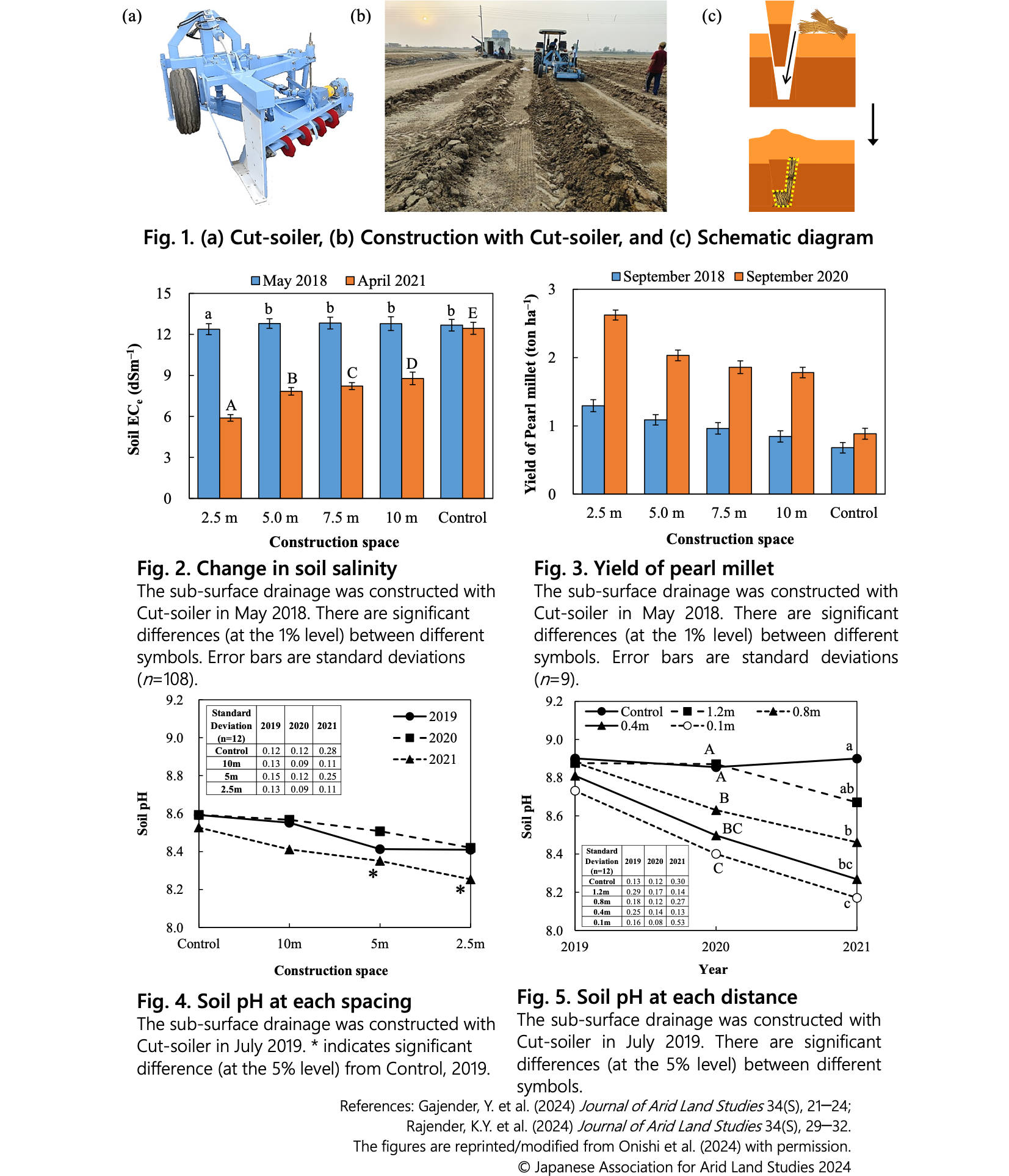The effect of improving soil salinity and pH by Cut-soilers (shallow sub-surface drainage) is high at a construction spacing of 2.5m
Description
In the Indo-Gangetic Plain (IGP), salinization due to irrigation with highly saline groundwater and poor drainage in the field has been a serious problem. In addition, soil sodicity, which increases the proportion of sodium ions, is occurring. Specifically, poor drainage due to sub-surface soil sodicity is worsening. Constructing sub-surface drainage is effective in mitigating salinization, but it is difficult for farmers to implement due to substantial costs. The Cut-soiler, a tractor attachment developed in Japan, can construct shallow sub-surface drainage (40-60 cm depth) while burying crop residues and/or soil improvement agents simply by towing it with a tractor (Fig. 1) (2022 JIRCAS Research Highlights: Shallow sub-surface drainage constructed with “Cut-soiler” mitigates soil salinity). Therefore, this technology could be a sustainable countermeasure against salinization for farmers in developing countries because it is inexpensive and easy to use.
In this study, we investigated the optimal construction spacing (2.5, 5, 7.5, 10 m) that achieved the highest effectiveness with this shallow sub-surface drainage in the salinized area of the IGP. Additionally, we implemented an effective measure to address soil sodicity by applying gypsum (CaSO4) at 10 t ha-1. This treatment replaces the sodium ions with calcium ions, promoting the leaching of sodium. Simultaneously, we buried rice straw at 6 t ha-1 using this technology and verified the reduction effect in soil pH. Comparing the spacings, the reduction in soil salinity (ECe) after 3 years of construction was highest at 2.5 m spacing (Fig. 2), and the yield of rainy season crops (pearl millet) was also highest at 2.5 m spacing (Fig. 3). On the other hand, comparing the soil pH, the reduction in soil pH after 2 years of construction was highest at the 2.5 m spacing (Fig. 4). Furthermore, the reduction in soil pH was higher the closer to the Cut-soiler construction line (Fig. 5).
This technology can be widely applied to similar salinized areas because it can be easily implemented using a tractor. To extend this method widely, a "Technical manual" focusing on shallow sub-surface drainage with Cut-soiler will be compiled. In India, this technology will be disseminated through the Indian Council of Agricultural Research (ICAR) and the Central Soil Salinity Research Institute (CSSRI). Since the construction method of shallow sub-surface drainage with Cut-soiler varies depending on the drainage situation around the field, it is necessary to check the drainage conditions in advance. The Cut-soiler is not equipped with wheels for transportation. The expected useful life of the Cut-soiler is approximately 7 years when constructing 30-50 ha per year. If there is no damage to the frame, it can be used continuously by replacing consumables.
Figure, table
- Research project
- Program name
- Term of research
-
FY2018-2024
- Responsible researcher
-
Yadav Gajender ( Central Soil Salinity Research Institute )
Yadav Rajender Kumar ( Central Soil Salinity Research Institute )
ORCID ID0000-0003-1436-2072Rai Arvind Kumar ( Central Soil Salinity Research Institute )
Kumar Satendra ( Central Soil Salinity Research Institute )
Neha ( JSPS Postdoctoral Fellowship for Research in Japan (Standard) )
Onishi Junya ( Rural Development Division )
Kameoka Taishin ( Rural Development Division )
Matsui Kayo ( Rural Development Division )
KAKEN Researcher No.: 10814189Lee Guenwoo ( Social Sciences Division )
ORCID ID0000-0001-5623-6205KAKEN Researcher No.: 80836643Kitagawa Iwao ( Institute for Rural Engineering, NARO )
- ほか
- Publication, etc.
-
Gajender Y et al. (2024) Journal of Arid Land Studies 34(S), 21-24.https://doi.org/10.14976/jals.34.S_21Rajender KY et al. (2024) Journal of Arid Land Studies 34(S), 29-32.https://doi.org/10.14976/jals.34.S_29
- Japanese PDF
-
2024_A10_ja.pdf1.14 MB
- English PDF
-
2024_A10_en.pdf503.69 KB
* Affiliation at the time of implementation of the study.

